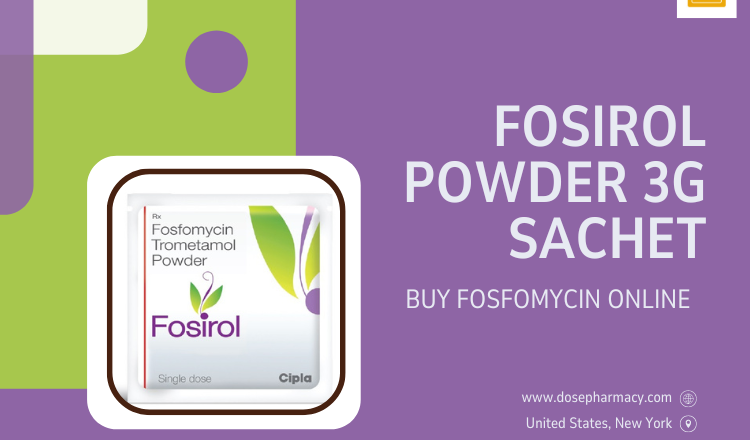Fosfomycin, a broad-spectrum antibiotic, has gained prominence in recent years due to its unique mechanism of action and effectiveness against a variety of bacterial pathogens, including multi-drug resistant strains. Discovered in the late 1960s, the fosfomycin 3gm sachet was initially derived from Streptomyces species. Its utility has been recognized primarily in the treatment of urinary tract infections (UTIs), but its applications extend to other bacterial infections as well, making it a versatile option in the antibiotic arsenal.
Mechanism of Action
Fosfomycin works by inhibiting the enzyme MurA (UDP-N-acetylglucosamine enolpyruvyl transferase), which is crucial in the first step of bacterial cell wall synthesis. By disrupting this process, fosfomycin effectively prevents the bacteria from forming a functional cell wall, leading to cell lysis and death. This mode of action is unique among antibiotics, which typically target different stages of cell wall synthesis or other bacterial processes. Consequently, fosfomycin can be particularly effective against bacteria that have developed resistance to other antibiotics.
Spectrum of Activity
Fosfomycin exhibits activity against a wide range of Gram-positive and Gram-negative bacteria. It is particularly effective against Escherichia coli and Enterococcus faecalis, the primary causative agents of uncomplicated UTIs. Additionally, it has shown efficacy against other pathogens such as Staphylococcus aureus, including methicillin-resistant Staphylococcus aureus (MRSA), and Pseudomonas aeruginosa. The ability of fosfomycin to penetrate bacterial biofilms further enhances its utility, as biofilms can often protect bacteria from the effects of antibiotics, leading to chronic infections.
Clinical Applications
Urinary Tract Infections
One of the most common indications for fosfomycin is the treatment of uncomplicated urinary tract infections. It is often administered as a single-dose oral therapy, which makes it convenient and increases patient compliance. Studies have demonstrated that fosfomycin is highly effective in eradicating the bacteria responsible for UTIs, with cure rates comparable to other standard treatments. Its use is especially valuable in cases where the causative bacteria are resistant to commonly prescribed antibiotics such as trimethoprim-sulfamethoxazole and fluoroquinolones.
Multi-Drug Resistant Infections
The rise of antibiotic-resistant bacteria has prompted the medical community to seek alternative treatment options. Fosfomycin’s unique mechanism of action and broad spectrum of activity make it a promising candidate in this context. It has been employed successfully in the treatment of infections caused by extended-spectrum beta-lactamase (ESBL) producing Enterobacteriaceae and carbapenem-resistant organisms. Fosfomycin is often used in combination with other antibiotics to enhance its efficacy and reduce the likelihood of resistance development.
Respiratory and Soft Tissue Infections
Beyond UTIs, fosfomycin has shown potential in treating respiratory tract infections, particularly those caused by Streptococcus pneumoniae and Haemophilus influenzae. It is also used in managing skin and soft tissue infections, especially those involving MRSA. The ability of fosfomycin to penetrate tissues and achieve therapeutic concentrations makes it a valuable option for these types of infections.
Osteomyelitis and Prosthetic Joint Infections
Fosfomycin’s penetration into bone and ability to disrupt biofilms make it a suitable option for treating osteomyelitis and prosthetic joint infections. These conditions are notoriously difficult to treat due to the presence of biofilms and the need for prolonged antibiotic therapy. Fosfomycin can be administered intravenously in these cases, often in combination with other antibiotics, to achieve the desired therapeutic outcomes.
Safety and Tolerability
Fosfomycin is generally well-tolerated, with a favorable safety profile. Common side effects include gastrointestinal symptoms such as diarrhea, nausea, and abdominal pain. These are typically mild and transient. Allergic reactions to fosfomycin are rare but can occur. One of the advantages of fosfomycin is its minimal impact on the gut microbiota, which reduces the risk of Clostridioides difficile infection, a common complication associated with broad-spectrum antibiotic use.
Resistance Development
While fosfomycin resistance is relatively uncommon, it is not unheard of. Resistance mechanisms include modifications to the target enzyme MurA, reduced permeability of the bacterial cell membrane to the antibiotic, and the presence of fosfomycin-modifying enzymes. To mitigate the risk of resistance development, fosfomycin is often used in combination with other antibiotics, particularly in the treatment of serious and multi-drug resistant infections.
Future Directions
The expanding problem of antibiotic resistance highlights the need for ongoing research and development of new antibacterial agents. Fosfomycin is being investigated for its potential use in novel therapeutic regimens and its effectiveness against emerging resistant pathogens. Studies are also exploring its role in combination therapies to enhance its efficacy and reduce resistance development.
Conclusion
Fosfomycin stands out as a versatile and valuable antibiotic in the fight against bacterial infections. Its unique mechanism of action, broad spectrum of activity, and effectiveness against resistant strains make it an important tool for clinicians. As antibiotic resistance continues to pose significant challenges, fosfomycin’s role in modern antibacterial therapy is likely to grow, providing a critical option for managing a range of bacterial infections. Continued research and prudent use of this antibiotic will be essential to preserve its efficacy for future generations. Read More….

